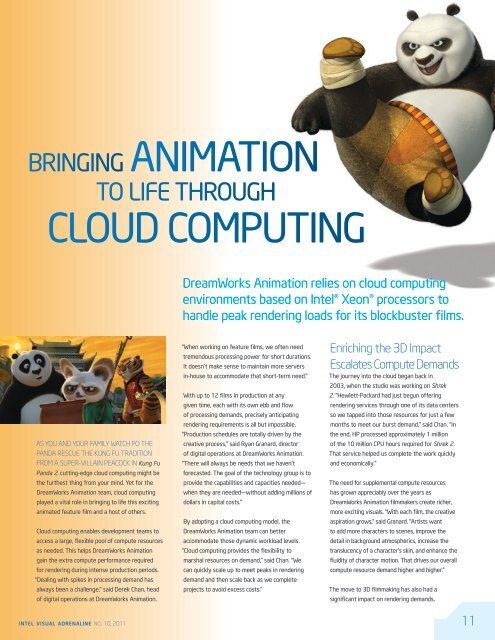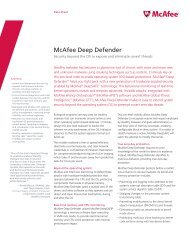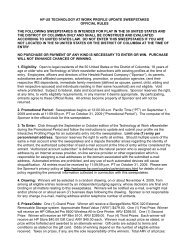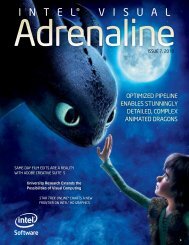Intel ® Visual
Intel ® Visual
Intel ® Visual
Create successful ePaper yourself
Turn your PDF publications into a flip-book with our unique Google optimized e-Paper software.
AS YOU AND YOUR FAMILY WATCH PO THE<br />
PANDA RESCUE THE KUNG FU TRADITION<br />
FROM A SUPER-VILLAIN PEACOCK IN Kung Fu<br />
Panda 2, cutting-edge cloud computing might be<br />
the furthest thing from your mind. Yet for the<br />
DreamWorks Animation team, cloud computing<br />
played a vital role in bringing to life this exciting<br />
animated feature film and a host of others.<br />
Cloud computing enables development teams to<br />
access a large, flexible pool of compute resources<br />
as needed. This helps DreamWorks Animation<br />
gain the extra compute performance required<br />
for rendering during intense production periods.<br />
“Dealing with spikes in processing demand has<br />
always been a challenge,” said Derek Chan, head<br />
of digital operations at DreamWorks Animation.<br />
ANIMATION<br />
BRINGING<br />
TO LIFE THROUGH<br />
CLOUD COMPUTING<br />
DreamWorks Animation relies on cloud computing<br />
environments based on <strong>Intel</strong><strong>®</strong> Xeon<strong>®</strong> processors to<br />
handle peak rendering loads for its blockbuster films.<br />
“When working on feature films, we often need<br />
tremendous processing power for short durations.<br />
It doesn’t make sense to maintain more servers<br />
in-house to accommodate that short-term need.”<br />
With up to 12 films in production at any<br />
given time, each with its own ebb and flow<br />
of processing demands, precisely anticipating<br />
rendering requirements is all but impossible.<br />
“Production schedules are totally driven by the<br />
creative process,” said Ryan Granard, director<br />
of digital operations at DreamWorks Animation.<br />
“There will always be needs that we haven’t<br />
forecasted. The goal of the technology group is to<br />
provide the capabilities and capacities needed—<br />
when they are needed—without adding millions of<br />
dollars in capital costs.”<br />
By adopting a cloud computing model, the<br />
DreamWorks Animation team can better<br />
accommodate those dynamic workload levels.<br />
“Cloud computing provides the flexibility to<br />
marshal resources on demand,” said Chan. “We<br />
can quickly scale up to meet peaks in rendering<br />
demand and then scale back as we complete<br />
projects to avoid excess costs.”<br />
Enriching the 3D Impact<br />
Escalates Compute Demands<br />
The journey into the cloud began back in<br />
2003, when the studio was working on Shrek<br />
2. “Hewlett-Packard had just begun offering<br />
rendering services through one of its data centers<br />
so we tapped into those resources for just a few<br />
months to meet our burst demand,” said Chan. “In<br />
the end, HP processed approximately 1 million<br />
of the 10 million CPU hours required for Shrek 2.<br />
That service helped us complete the work quickly<br />
and economically.”<br />
The need for supplemental compute resources<br />
has grown appreciably over the years as<br />
DreamWorks Animation filmmakers create richer,<br />
more exciting visuals. “With each film, the creative<br />
aspiration grows,” said Granard. “Artists want<br />
to add more characters to scenes, improve the<br />
detail in background atmospherics, increase the<br />
translucency of a character’s skin, and enhance the<br />
fluidity of character motion. That drives our overall<br />
compute resource demand higher and higher.”<br />
The move to 3D filmmaking has also had a<br />
significant impact on rendering demands.<br />
intel visual adrenaline no. 10, 2011 11













